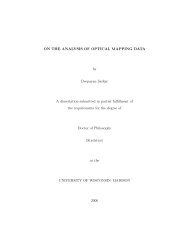Struggles with Survey Weighting and Regression Modeling paper
Struggles with Survey Weighting and Regression Modeling paper
Struggles with Survey Weighting and Regression Modeling paper
You also want an ePaper? Increase the reach of your titles
YUMPU automatically turns print PDFs into web optimized ePapers that Google loves.
SURVEY WEIGHTING AND REGRESSION MODELING 159<br />
This leads naturally to multilevel modeling to obtain<br />
stable estimates in all the poststratification cells, even<br />
those <strong>with</strong> zero or one respondent. Choices must then<br />
be made in the modeling of interactions.<br />
For example, in our time-trend estimation problem,<br />
we could model y = β 0 + β 1 z + β 2 X + β 3 Xz + error,<br />
where β 3 is a vector of coefficients for the interaction<br />
of X <strong>and</strong> time. We would then be interested in<br />
β 1 + β 2 (X 2001 − X 1999 ) + β 3 X 2001 (as in the example<br />
at the end of Section 1.4). Where should the interaction<br />
modeling stop? A simulation study (Cook <strong>and</strong><br />
Gelman, 2006) suggests that, in this example, efficient<br />
<strong>and</strong> approximately unbiased estimators are obtained by<br />
including interactions of the time indicator <strong>with</strong> all the<br />
survey adjustment factors; as a general approach, however,<br />
including all interactions can yield unstable estimates.<br />
The practical problem of adjusting for survey<br />
nonresponse leads to general questions of inference under<br />
multiway interactions, an issue that becomes even<br />
more relevant in small-area estimation.<br />
Gelman <strong>and</strong> Carlin (2002) <strong>and</strong> Park, Gelman <strong>and</strong> Bafumi<br />
(2004) discuss the estimation of state-level opinions<br />
from national polls, using a hierarchical logistic<br />
regression <strong>with</strong> demographics <strong>and</strong> state effects, followed<br />
by poststratification on Census population totals<br />
for 64 demographic categories in each of the 50 states.<br />
The method worked well, but it is not clear how it<br />
would perform if the model included interactions of<br />
demographic <strong>and</strong> state effects.<br />
3. USING REGRESSION MODELING TO CONNECT<br />
WEIGHTING AND POSTSTRATIFICATION<br />
When cell means are estimated using certain linear<br />
regression models, poststratified estimates can be interpreted<br />
as weighted averages (Little, 1991, 1993). The<br />
idea is to work <strong>with</strong> the poststratified estimate (2)—<br />
an average over cell estimates ˆθ j , <strong>with</strong> the regression<br />
model providing the ˆθ j ’s based on characteristics of the<br />
cells j. Under certain conditions, the poststratified estimate<br />
can be reinterpreted as a weighted average of the<br />
form (3), <strong>and</strong> then we can solve for the cell weights W j<br />
<strong>and</strong> the unit weights w i .<br />
3.1 Classical Models<br />
Full poststratification. The simplest case is full<br />
poststratification of raw data, in which case the cell<br />
estimates are the cell means, ˆθ j =ȳ j ,<strong>and</strong>(2) becomes<br />
∑ Jj=1<br />
full poststratification: ˆθ PS N j ȳ j<br />
= ∑ Jj=1<br />
,<br />
N j<br />
which is equivalent to (3) <strong>with</strong> cell weights W j ∝ N j or<br />
unit weights w i ∝ N j(i) /n j(i) ,wherej(i) is the poststratification<br />
cell to which unit i belongs.<br />
This estimate can also be viewed as a classical regression<br />
including indicators for all J poststratification<br />
cells.<br />
No weighting. The other extreme is no weighting,<br />
that is, unit weights w i = 1foralli, which is equivalent<br />
to poststratification if the cell estimates ˆθ j are all equal<br />
to the sample mean ȳ, which in turn corresponds to<br />
classical regression including only a constant term.<br />
Classical regression on cell characteristics. Intermediate<br />
cases of weighting can be obtained by regression<br />
models that include information about the poststratification<br />
cells <strong>with</strong>out going to the extreme of fitting<br />
a least-squares predictor to each cell. For example,<br />
in the CBS/New York Times pre-election surveys,<br />
one could regress y on indicators for sex, ethnicity, age,<br />
education <strong>and</strong> region, <strong>with</strong>out necessarily including all<br />
their interactions.<br />
Suppose the regression model is y ∼ N(Xβ, σ 2 y I).<br />
We shall use X to represent the n × k matrix of predictors<br />
in the data, <strong>and</strong> X pop to represent the J × k<br />
matrix of predictors for the J poststratification cells.<br />
We also label the vector of poststratum populations as<br />
N pop = (N 1 ,...,N J ), <strong>with</strong> a sum of N = ∑ J<br />
j=1 N j .<br />
The estimated vector of regression coefficients is<br />
then ˆβ = (X t X) −1 X t y, <strong>and</strong> the estimated cell means<br />
are X pop ˆβ. The poststratified estimate of the population<br />
mean is then<br />
(5)<br />
(6)<br />
classical regression:<br />
ˆθ PS = 1 N<br />
J∑<br />
j=1<br />
N j (X pop<br />
j<br />
ˆβ)<br />
= 1 N (N pop ) t X pop (X t X) −1 X t y,<br />
which can be written as ˆθ PS = 1 n<br />
∑ ni=1<br />
w i y i , <strong>with</strong> a<br />
vector of unit weights,<br />
(7)<br />
w =<br />
( n<br />
N (N pop ) t X pop (X t X) −1 X t ) t<br />
.<br />
For convenience, we have renormalized these weights<br />
to sum to n (see below). In (7), w is a vector of length<br />
n that takes on at most J distinct values. The vector of<br />
J possible unit weights (corresponding to units in each<br />
of the J poststrata) is<br />
(8)<br />
w pop =<br />
( n<br />
N (N pop ) t X pop (X t X) −1 (X pop ) t ) t<br />
,
















